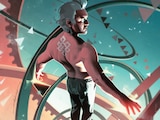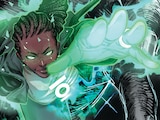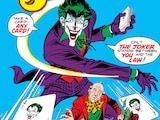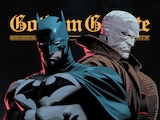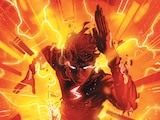This week on Max, the unlikeliest hero in the history of Gotham City lands his own animated series. Out of all the costumed mooks in Noonan’s Sleazy Bar, how did Kite Man end up with his own show? If you’re watching Harley Quinn, then you already know. The man of kites has been earning a rep as our favorite loveable loser who approaches crime with a can-do attitude and never lets the absurdity of his life and his world take the wind from his sails.
Do kites have sails? Look, I’m a comic book guy, not a kite guy. My point is, even if you are familiar with Kite Man from Harley Quinn, you might have wondered where this guy came from. “Is he really a classic Batman villain?” I hear you asking. “And if he is, how come I’ve never seen him around?” We’re here to cast your eyes towards the skies and help you do some kite watching.
We assume kite watching is a thing, at least. You see, a kite is also a kind of bird, and… You know what, let’s just get to the origin.
CRIMES OF THE KITE MAN

Legendary comic book artist Dick Sprang’s final gift to the Batman title was Kite Man’s design in 1960’s Batman #133 story, “Crimes of the Kite-Man.” His initial flight was just eight pages long, in an issue which dedicated most of its attention to a Bat-Mite/Batwoman romance, but his signature joie de vivre was immediately apparent. Swooping in from impossible heights with a jet-propelled kite, Kite Man’s first crime was stealing the ruby from a visiting rajah’s turban at a Gotham rooftop gala, cackling all the way at his own audacity and excitement over the start of a promising sensational supercriminal career.
After giving Batman and Robin the slip, Kite Man follows up his stunning debut by taking a job breaking a powerful gangster out of prison as a passenger on one of his colossal kites. Capturing Batman with a surprise kite to the face, Kite Man plans to strap the Caped Crusader to a kite and charge his enemies for the opportunity to take shots at him. But before he can see that plan through, Batman smuggles a dragon kite out of Kite Man’s hideout to take down the air-riding upstart himself. The story concludes with Batman putting Kite Man’s glider kite up on display in the Batcave, and we wouldn’t see him again for another nineteen years.
WHATEVER HAPPENED TO KITE MAN?

Kite Man sat out the rest of the Silver Age, but returned from obscurity in his first—and only—full-issue battle against Batman in 1979’s Batman #315, “Danger on the Wing!”
You read that right. Over 55 years of comic history, Kite Man only ever fought Batman twice. Meeting his foe in the air this time with a Bat-Glider of his own, Batman ran Kite Man back into custody and out of town. This incarnation of Kite Man would never again return to Gotham City.
Instead, Kite Man tried to make a go at antagonizing another airbound superhero entirely—Hawkman. In 1986’s Hawkman #4, Kite Man flies into Midway City looking to start a fight with Hawkman and Hawkgirl, but gets more than he bargained for when Zatanna appears to provide some unexpected backup. (It’s soon after this, in a 1987 Who’s Who entry, that we learn Kite Man’s real name is Charles “Chuck” Brown.)

So, at this point, imagine you’re Kite Man. You’ve been beaten by Batman twice. You try taking on some bird-themed enemies who may be more your speed, and an actual sorceress shows up to completely outclass you. Where do you go from here?
Well, from 2000–2002, the Young Justice comics give us an idea. Kite Man is seen through the series as one of many super-villains lying low in the small European nation of Zandia, home to the Church of Blood and a robust super-villain amnesty program. Kite Man makes his bones as a sentry for the country’s ruler, Lady Zand, reporting developments to her from the nation’s skies.
But Kite Man’s flights of fancy could only last so long. In 2006, 52 #25 reveals Kite Man’s body among the amassed casualties of Intergang-boss-turned-crime-cult-figurehead Bruno Mannheim, killing his way through the small-time villains who refused the call to join his organization. Alas, poor Kite Man. Sooner or later, the wind always dies.
KITE MAN FLIES AGAIN

Today’s Kite Man resurgence may be due in part to the 2008 animated series Batman: The Brave and the Bold, recasting Plastic Man as a former henchman in Kite Man’s crew before the accident which gained him his superpowers. Plastic Man’s first heroic act was acting as a witness against Kite Man in his own trial, for which Kite Man would take his revenge in the 2002 episode, “Long Arm of the Law.”
But let’s be serious. Unless you’re a serious Batman collector, if you know Kite Man from the comics at all, it’s probably due to the influence of Tom King’s Batman run. A couple of continuity reboots following Kite Man’s untimely demise, the formerly departed villain was back in action with 2016’s Batman #6. Recapturing Kite Man’s unbridled glee at his own audacity from his original 1960 appearance, it’s King who gives the returned villain his signature cry of shouting his own name in the midst of a daring heist. It’s in a penthouse heist for a woman’s pearl necklace that our green-clad glider intones his very first “Kite Man. Hell Yeah.” before his apprehension by Gotham City’s latest super-powered protector, Gotham Girl.
Kite Man would remain a staple of King’s run for the next several years, even earning a surprisingly touching tragic backstory in “The War of Jokes and Riddles,” where we learn of Kite Man’s past as a criminal engineer who helped design the Jokermobile, an association which would lead the Riddler, in a turf war with his clown rival, to poison Kite Man’s son. It was in Chuck Brown Junior’s memory of their favorite activity together that the former engineer would take on the persona of Kite Man, joining the War of Jokes and Riddles on the side of Jokes.

Which brings us to Harley Quinn. Since 2019, the vision by showrunners Justin Halpern and Patrick Schumacker has supplanted even King’s interpretation as the essential Kite Man. In Harley Quinn’s Gotham, Kite Man is the ultimate loser among loser super-villains. Disrespected by all his peers—yet, at first, still more respected than Harley thanks to male privilege—Kite Man inherits King’s “hell yeah” attitude and none of his tragedy. His whole situation of trying to be a kite-themed super-villain is tragic enough.
The frustrating, yet constantly positive, weirdly lovable take on the character with a Quixotic dream of rising to villainous infamy on the back of his kites even manages to capture the heart of Poison Ivy until she realizes the scope of her feelings for Harley—something she really could have timed better, as they break up at the altar of their own wedding so that Ivy can ride off with Harley.
So…imagine, again, that you’re Kite Man. What do you do from here? Well, that’s exactly what we’re going to see in his brand-new animated series, Kite Man: Hell Yeah! See, you even know where the tagline comes from now. Taking over the super-villain bar where we first met him in the Harley Quinn animated series, Kite Man and his new beau Golden Glider are about to show us just how high a kite can soar. Or, possibly, how destructive it can be when they fall. But will it be a laugh-out-loud romp either way?
I think you know the answer to that.
The first two episodes of Kite Man: Hell Yeah! are now streaming on Max.
Alex Jaffe is the author of our monthly "Ask the Question" column and writes about TV, movies, comics and superhero history for DC.com. Follow him on Bluesky at @AlexJaffe and find him in the DC Official Discord server as HubCityQuestion.

